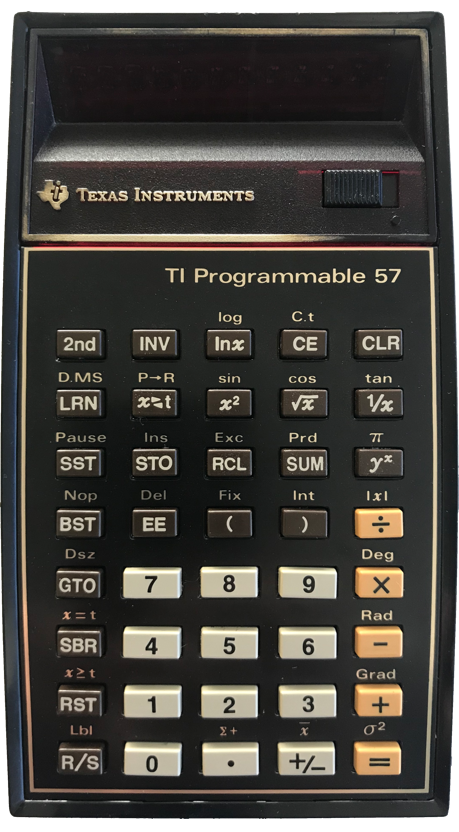PCjs Machines
Home of the original IBM PC emulator for browsers.

TI-57 Tips and Tricks
Powering Off The TI-57 Display
The post “Give your TI-57 Constant Memory” describes a trick for powering off the calculator while preserving memory. It’s more accurately described as a means of powering off the display without powering off the entire calculator, and since the display is (apparently) what consumes the most power, you could “pretend” that you turned your calculator off, even though you really hadn’t.
This trick was previously reported in an old TI PPC Notes newsletter from the “TI Programmable Calculator Club” in Lanham, MD. The article in Vol. 7, No. 6, Page 9 reported that this trick was in turn previously reported in a French magazine, “L’Ordinateur de Poche” (No. 4 from 1982).
Rather than repeat either of those repetitions of the trick, both of which suffer from a little vagueness, I’ll repeat a better explanation from rskey.org’s page on the TI-57. It involves entering two program steps at the end of the TI-57’s 50-step program memory (at step 48), where it’s conveniently out of the way of any other programs you might write, and then executing it when you’re ready to power the screen off:
Briefly, you need to enter the two steps with the following keystrokes: GTO 2nd 4 8 LRN 2nd Exc SST 2nd Lbl 1. To put the calculator in sleep mode, enter: CLR GTO 2nd 4 8 R/S INV STO 3 +/- +/-. To exit sleep mode, enter: INV 2nd Fix CLR.
Use the PCjs TI-57 Emulator below to give it a try!
Overriding PCjs TI-57 Settings
The PCjs TI-57 Emulator allows you to override a variety of configuration properties using URL parameters, including speed and color settings. For example:
https://pcjs.org/machines/ti/ti57/tips/?color=lime
Currently, the following properties may be overridden, within the given minimums and maximums:
- cyclesPerSecond (default speed is 650000; minimum is 100000 and maximum is 1600000)
- yieldsPerSecond (default is 60; minimum is 30 and maximum is 120)
- yieldsPerUpdate (default is 30; minimum is 1 and maximum is yieldsPerSecond)
- color (default LED digit color is red)
- backgroundColor (default LED digit background color is none, for a transparent background)
- colorROM (default ROM activity LED color is green)
- backgroundColorROM (default ROM activity background color is black)
So, if you want a TI-57 with Bright Green LEDs, you’ve got it!
Note that ROM activity colors apply only to the “ROM Activity” window that appears on a TI-57 Diagnostics page.
The yieldsPerSecond property is essentially the emulator’s LED refresh rate, whereas yieldsPerUpdate determines how frequently any other non-LED elements on the page should be updated (e.g., current speed, current register values, etc.)
PCjs TI-57 Emulator
